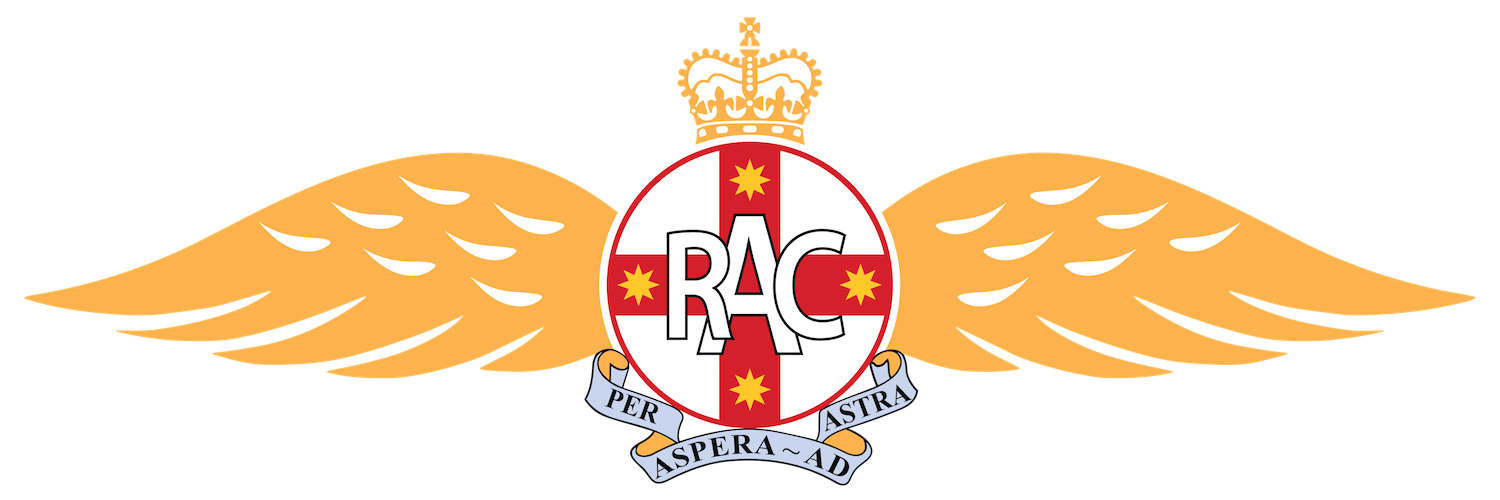Our Heritage
History of the Royal Aero Club of NSW
Our origins can be traced back to October 1914, when a visionary group of young officers from the newly formed Australian Flying Corps gathered at Point Cook, Victoria. United by their passion for aviation they established the Australian Aero Club and forged an affiliation with the Royal Aero Club of Great Britain. World War 1 briefly halted progress, but the idea of a dedicated NSW Section took shape in 1919.
On May 23rd 1919, a key meeting was held at Royal Society House in Sydney’s CBD where the foundation of our club was laid. Colonel Oswald Watt, a renowned figure celebrated for his brilliance and bravery in the skies of France during World War 1 was elected our inaugural president. It was under his leadership that the NSW Section of the Australian Aero Club received its Certificate of Incorporation on November 10th 1920.
Guided by Watt’s unwavering dedication and boundless enthusiasm, aviation in Australia found its true direction. His tireless efforts led to significant milestones, including government controls on aircraft airworthiness, safety standards, and pilot licensing. At one stage, the NSW Section even issued its own certificates of airworthiness which solidified its authority for aviation in NSW. Watt’s pursuit of progress elevated the club to become a prestigious and influential organisation within New South Wales.
Watt’s enduring legacy is deeply intertwined with aviation safety. His “Safety First” campaign sparked a national movement culminating in the introduction of Federal Bill for the control of civil aviation. The Air Navigation Act of 1920 and the Air Navigation Regulations of 1921 laid the foundation for prioritising safety in the skies and were direct outcomes of Colonel Watt’s unwavering determination.
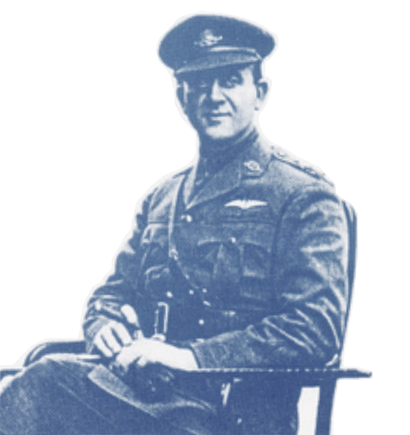
Photograph of Oswald Walt OBE.
Founding President of the Royal Aero Club.
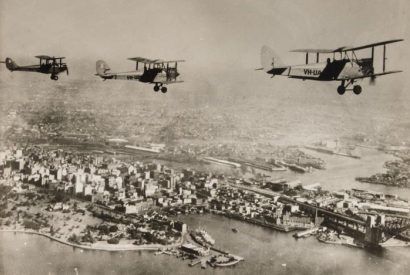
Royal Aero Club Formation Flight over Sydney Harbour.
(Image Courtesy of the Museum of Applied Arts & Sciences)
In 1926, the Department of Aviation approached our club with a proposal to establish a flight training section. Recognising the value of this opportunity, we eagerly entered into an agreement wherein our club would organise and maintain the flight training operations. In return, the government provided us with three de Havilland DH.60 Cirrus Moths. The first of these aircraft was delivered in July 1926, marking the start of an exciting new chapter.
With one instructor, one engineer, and a part-time secretary our training facility was swiftly established by August of that year. The demand for flying training surged, leading to the appointment of additional instructors were appointed and the club’s decision to purchase its own aircraft to supplement the three on loan from the government. Our club soared, fuelled by the soaring passion and growing demand for aviation training. Several of our early flight instructors including Charles Kingsford Smith, George Littlejohn, and Charles Ulm also went on to become legends of aviation.
As our fleet and operations grew, the need for maintenance and repair facilities became apparent. With no local suppliers, the only viable option was to send aircraft to Melbourne. However we recognised the need to provide local facilities and purchased a site at Mascot for 1200 pounds. We engaged Sidney Williams & Co Pty. Ltd. to construct a hangar with the structure becoming known as the “Royal Aero Club’s All Steel Service and Repair Hangar”.
Having established our position as an aviation trailblazer in our early years, we received a great honour in 1935. Recognising our significant contributions to aviation development in New South Wales, King George V granted us the prestigious prefix ‘royal’. From that moment, we became known as the Royal Aero Club of NSW.
At this stage, our membership had grown to approximately 400 and our fleet boasted eight aircraft. Within a decade of our first flight, we had trained over 400 pilots and in the process flown a remarkable distance of 2,000,000 miles with our aircraft.
During the 1930s, we delighted audiences across the state as hosted “Aero Pageants”. These highly anticipated events served as mini-airshows, captivating audiences with thrilling aerial displays from our own formation flying team, as well as the Royal Australian Air Force. The pageants also included parachute jumps and competitions with interstate aircraft which would draw aviation enthusiasts to attend from all corners of Australia.
With the outbreak of World War II in 1939, the Royal Aero Club like many other flight training organisations dedicated our resources to support the war effort. We played a crucial role providing skilled instructors, aircraft, and maintenance facilities to train aspiring cadets for the Royal Australian Air Force.
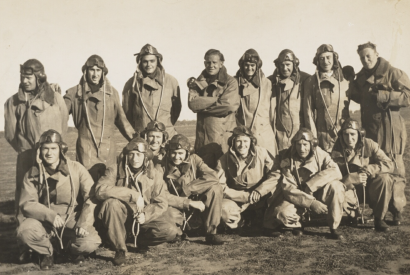
Photograph of Royal Aero Club members at Mascot.
(Image Courtesy of the State Library of New South Wales)
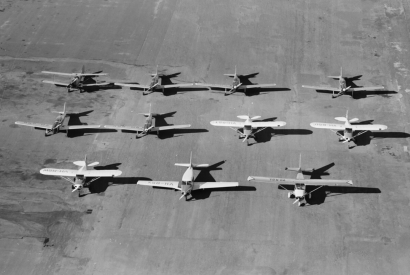
Royal Aero Club Fleet at Bankstown in the late 1950s.
(Image Courtesy of the State Library of New South Wales)
As the Jet Age dawned and Mascot transformed into Sydney’s International Airport, the Department of Civil Aviation directed us to relocate to Bankstown Aerodrome. In 1949, we settled into the former Royal Australian Air Force hospital premises, which has become available after the end of World War II. Our new facility was officially opened by our Patron and Governor of New South Wales, Sir John Northcott. The ceremony was followed by a delightful celebration featuring a cocktail party, buffer dinner, and a joyous dance held in our brand-new clubhouse
During this transformative period, our fleet also underwent a remarkable evolution which reflected our commitment to staying at the forefront of aviation advancements. We transitioned from the iconic de Havilland Tiger Moths to the versatile de Havilland Chipmunks, and later embraced the excellence of Piper Aircraft. By the late 1950s, our fleet consisted of 11 aircraft including 1x de Havilland DH.82 Tiger Moth, 5x de Havilland DHC-1 Chipmunks, 4x Piper PA22 Tri-Pacers, and 1x PA-24 Comanche.
As we progressed into the 1960s and 1970s, our fleet continued to evolve with the addition of more Piper aircraft models. The Piper PA38 Tomahawks and PA28 Cherokees became integral parts of our fleet, offering enhanced capabilities and meeting the evolving needs of our members.
However despite our rich history and achievements, the late 1980s posed significant challenges for the club. This unfortunate situation led to financial difficulties and ultimately the club being placed into receivership during the 1990s. It was a challenging period that cast a temporary shadow over the Royal Aero Club.
Nevertheless, the spirit and passion for aviation persisted and in 2023 a group of dedicated individuals came together with a shared vision to resurrect and re-establish the Royal Aero Club. Driven by a deep appreciation for our rich history and a commitment to carrying it forward, there is now a renewed sense of purpose to continue our mission as we embrace the future with great enthusiasm as we shape the next generation of pilots, leaders, and aviators.
.
Today we a registered not-for-profit organisation and appear on the NSW Fair Trading Incorporated Associations Register. We are also uniquely positioned as the largest volunteer-run and not-for-profit Part 141 Flight Training Organisation in the Southern Hemisphere so let us put wings on your dreams!
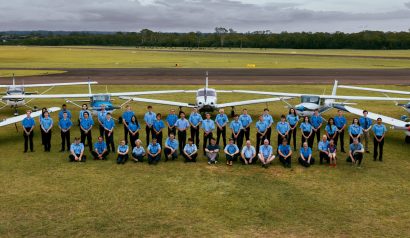
Royal Aero Club in 2024
Subscribe to our newsletter
Sign up for our newsletter to stay connected and informed of all the latest updates, news, and exclusive specials!

Connect with us
Acknowledgement of Country
The Royal Aero Club of New South Wales acknowledges the original custodians of Camden Airport. Recognising peoples of the Gundungurra, Tharawal, and Dharug Nations have accessed the land beneath us and skies above us for thousands of years. We pay respect to their elders and communities past, present, and emerging.
Airservices Australia Links
ARN: 1223948
Granted under the Civil Aviation Safety Regulations (CASR) 1998
Approval Number: CASA.141 FTO.0433
© Copyright 2024 Royal Aero Club of New South Wales Incorporated | ABN: 72 481 171 323
